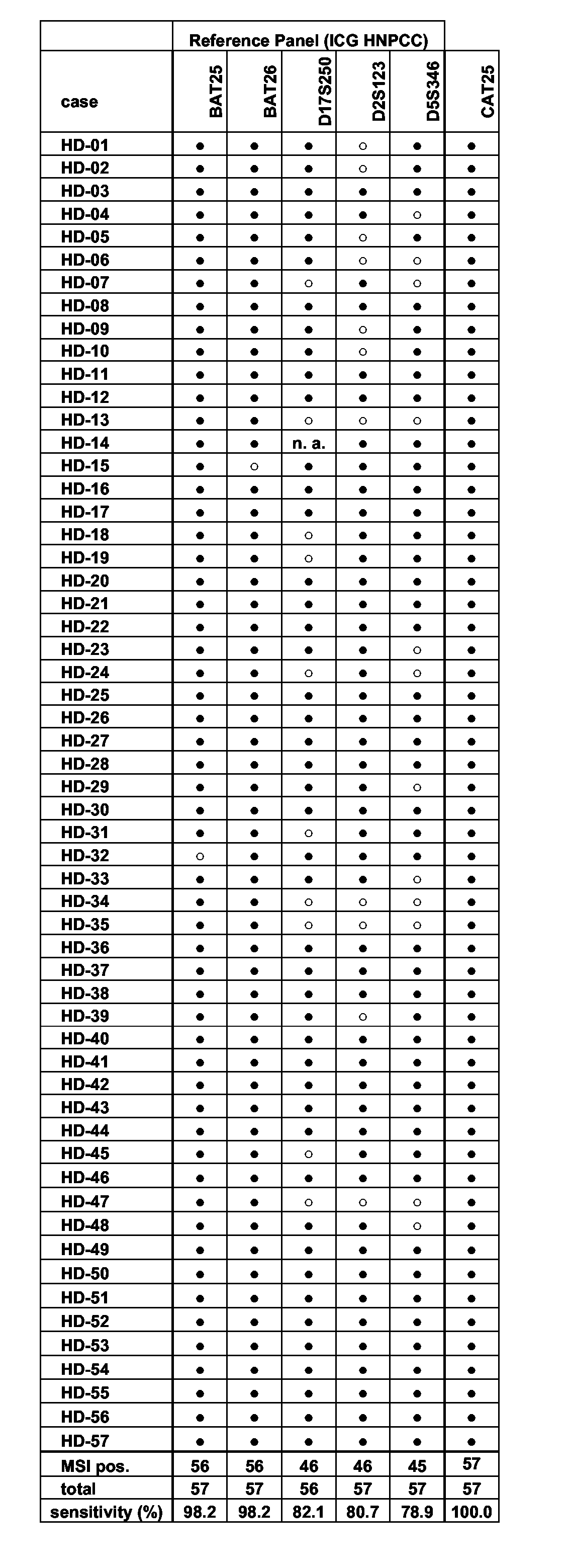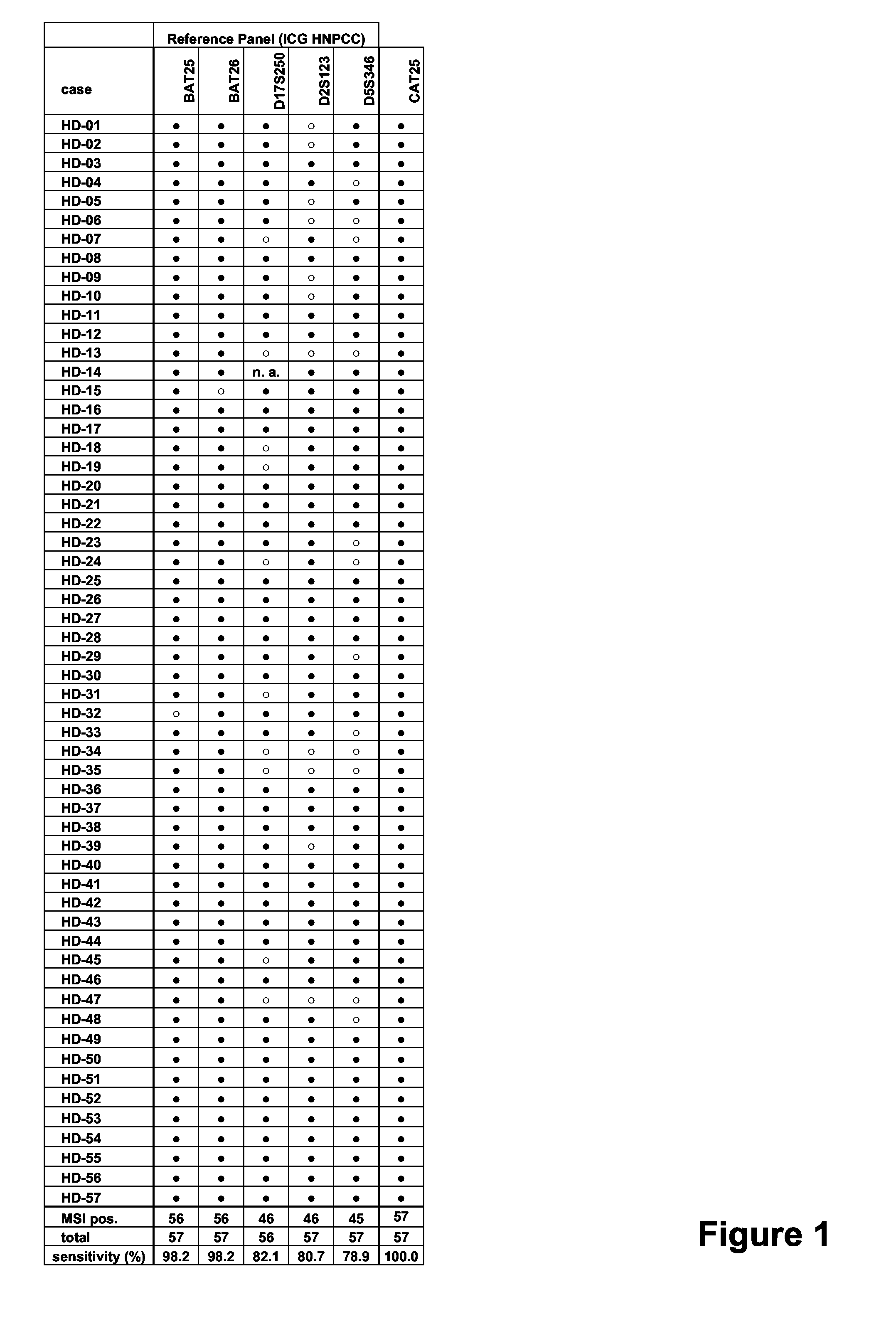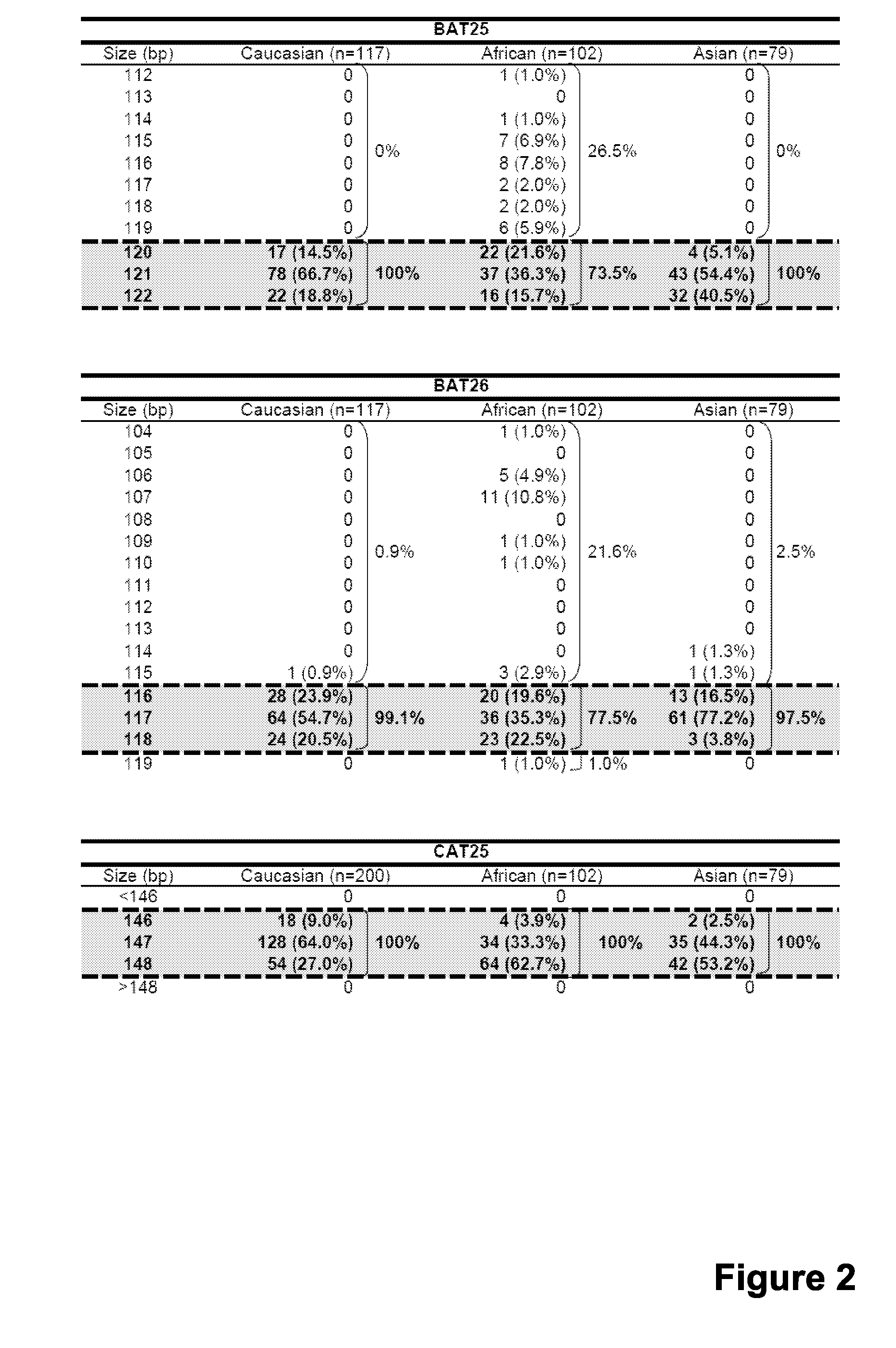Compounds and Methods for Assessment of Microsatellite Instability (Msi) Status
a technology of instability and compounds, applied in the field of compounds and methods for assessing the status of microsatellite instability, can solve the problems of inapplicability of high throughput screening to msi analysis, time-consuming, laborious and expensive testing procedures, and several limitations of ihc as a screening method when used alone, and achieve the effect of more efficient screening strategies
- Summary
- Abstract
- Description
- Claims
- Application Information
AI Technical Summary
Benefits of technology
Problems solved by technology
Method used
Image
Examples
example 1
Assessment of Instability at the CAT25 Mononucleotide Repeat in MSI-H and MSS Colorectal Carcinomas
Sample Preparation and DNA Extraction
[0118] Genomic DNA was isolated from formalin-fixed, paraffin-embedded CRC specimens (n=117) after manual microdissection using a commercially available kit (DNeasy Tissue KIT, Qiagen, Hilden, Germany). For the evaluation of allele distribution, genomic DNA was isolated from non-diseased tissue samples of non-related donors (n=200).
Microsatellite Instability Analysis and Multiplex PCR
[0119] Typing of microsatellite instability was carried out using the standard ICG-HNPCC marker panel as described (Boland et al. 1998, Sutter et al. 1999). Tumors were classified as highly microsatellite unstable (MSI-H) if more than 30% of the markers displayed instability, low microsatellite unstable (MSI-L) with instability in only one marker, or microsatellite stable (MSS) if no instabilities were detected.
[0120] PCR primers for the amplification of CAT25 (f...
example 2
Assessment of Instability at the CAT25 Mononucleotide Repeat in Colorectal Adenomas of the Microsatellite Instability Phenotype
Sample Preparation and Microsatellite Analysis
[0129] Preparation of Colorectal Adenomas, DNA Extraction, and Microsatellite analysis were performed as described in Example 1.
[0130] Fourteen colorectal adenomas which were previously typed as MSI-H by using the standard ICG-HNPCC marker panel (Boland et al. 1998) were analyzed for shifts at the T25 mononucleotide repeat located in the 3′-UTR of the CASP2 gene (CAT25). Mutation frequency of the microsatellite loci CAT25, BAT25, and BAT26 are depicted in Table 1.
TABLE 1Mutation frequency in MSI-H colorectal adenomasmutation frequency (%)CAT2513 / 14 (92.9)BAT2511 / 14 (78.6)BAT2611 / 13 (84.6)
[0131] Mean shift lengths observed in colorectal adenomas were 6.0 for CAT25, 4.6 for BAT25, and 5.0 for BAT26. Thus, CAT25 exceeded BAT25 and BAT26 in the detection of MSI-H colorectal carcinomas concerning the sensitivity...
example 3
Assessment of Instability at the CAT25 Mononucleotide Repeat in Extracolonic Malignancies of the Microsatellite Instability Phenotype (Endometrial Cancer, Ovarian Cancer, Urothelial Cancer)
Sample Preparation and Microsatellite Analysis
[0132] Preparation of Tumor Tissue Samples, DNA Extraction, and Microsatellite analysis were performed as described in Example 1. For the amplification of BAT25, an alternative antisense oligonucleotide primer (5′-TATGGCTCTAAAATGCTCTGTTC-3′) was used, resulting in a mean main product length of 109 nt (FIG. 5).
[0133] Extracolonic malignancies (n=7) which were previously typed as MSI-H by using the standard ICG-HNPCC marker panel (Boland et al. 1998) were analyzed for shifts at the T25 mononucleotide repeat located in the 3′-UTR of the CASP2 gene. For amplification, a multiplex system combining CASP2, BAT25, and BAT26 in one reaction was applied (detailed description in Example 1). By using this approach, 7 (100%) out of 7 extracolonic tumour lesions...
PUM
| Property | Measurement | Unit |
|---|---|---|
| volume | aaaaa | aaaaa |
| length | aaaaa | aaaaa |
| polymorphic typing | aaaaa | aaaaa |
Abstract
Description
Claims
Application Information
 Login to View More
Login to View More - R&D
- Intellectual Property
- Life Sciences
- Materials
- Tech Scout
- Unparalleled Data Quality
- Higher Quality Content
- 60% Fewer Hallucinations
Browse by: Latest US Patents, China's latest patents, Technical Efficacy Thesaurus, Application Domain, Technology Topic, Popular Technical Reports.
© 2025 PatSnap. All rights reserved.Legal|Privacy policy|Modern Slavery Act Transparency Statement|Sitemap|About US| Contact US: help@patsnap.com



